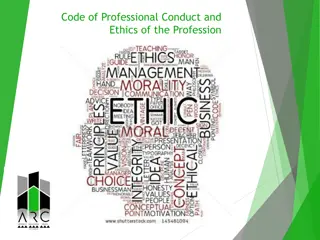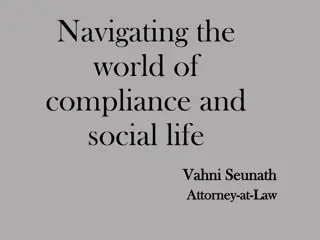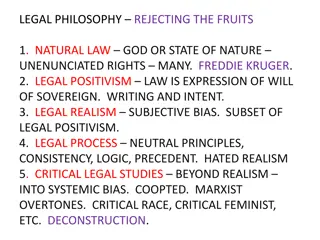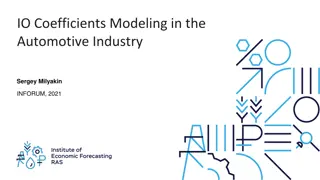Evolution of the Legal Profession: Adapting to Market Trends and Technological Changes
Changes in the legal profession are evident as firms transform with the adoption of technology, shifting towards data-driven decision-making, and focusing on industry-specific expertise. Successful law firms are expected to adapt by leveraging data, sharing risks, and coalescing around specialized strengths to meet evolving client demands effectively.
Download Presentation

Please find below an Image/Link to download the presentation.
The content on the website is provided AS IS for your information and personal use only. It may not be sold, licensed, or shared on other websites without obtaining consent from the author.If you encounter any issues during the download, it is possible that the publisher has removed the file from their server.
You are allowed to download the files provided on this website for personal or commercial use, subject to the condition that they are used lawfully. All files are the property of their respective owners.
The content on the website is provided AS IS for your information and personal use only. It may not be sold, licensed, or shared on other websites without obtaining consent from the author.
E N D
Presentation Transcript
REINVENTING YOURSELF REINVENTING YOURSELF How Lawyers Can Adapt to Changes in the Profession, Market Trends, Diversification and Adaptation to Change
Changes in the Profession In 1999 Baker McKenzie was the largest law firm in the world with 2,500 lawyers. Today, 20 years later, Dentons has over 10,000 lawyers. https://www.law.com/americanlawyer/2019/09/03/after-40-years- of-constant-change-whats-next-for-the-legal- industry/?slreturn=20200017105233
Changes in the Profession Everything that can be taken out of the hands of subject-matter experts and handed over to the process experts and technologists will be, says Orrick, Herrington & Sutcliffe Chairman and CEO Mitch Zuklie. There will be far fewer associates sitting in rooms with documents and more strategic partnerships among law firms and legal tech providers. Id.
Changes in the Profession The fallout from its adoption (technology) will prompt a reallocation of labor that should also upset law firms traditional model, which features an army of associates and a smaller cadre of partners at the top. Id. Some expect firms to reach a 60-40 split between lawyers and other professionals compliance experts and business development staff along with technologists and process experts. Id.
Changes in the Profession Firms will be able to leverage data to identify the profiles of prospective attorneys who thrive in their systems, while law school graduates will also have more information at their disposal. Our newest lawyers are far more sophisticated in their awareness about the opportunities and burdens of the profession and the business. Id.
Changes in the Profession Successful firms will coalesce around chosen areas of strength, rather than aiming to deliver everything to everyone, recognizing clients want industry-specific expertise as well as general legal acumen. And they ll need to share more data and more risk. Increasingly, the cost of inefficiency will be a cost that s borne by law firms, not by legal departments. Id.
Changes in the Profession McNamara, of Dentons, was recently looking at press reports from the late 1990s, when Price Waterhouse merged with Coopers & Lybrand. The questions, since refuted, about whether such a firm was too big to succeed have informed his own thinking about the legal industry. There s no limit to scale, he says. Id.
Changes in the Profession With more non-lawyer specialists finding professional homes in law firms, it s a short leap to hybrids between law firms and professional services operations. Imagine consultants and accountants working together with lawyers and technologists to solve clients increasingly complex problems. And what about a high-profile merger between a Big Four firm and a global law firm? I wouldn t rule it out. Id.
Changes in the Profession First key takeaway: Technology is in fact making many aspects of old law practice not only outdated but completely unnecessary. Gone are the days of lawyers handling all of their matters in house. Outside services including consultants have become the norm not the exception. Law firms will need to insource these services as part of their overhead to attract clients and/or create strategic alliances with outsource providers to appease the economic concerns of clients and stay competitive. Clients will no longer pay law firms for non-attorney work.
TECHNOLOGY WILL MAKE MANY OLDER ATTORNEYS OBSOLETE IF THE DO NOT ADAPT. THE YOUNGER GENERATION OF ATTORNEYS ARE TECH SAVVY.
Changes in the Profession ABA Model Rule 11 was revised in 2012 to add Comment 8, which says, [t]o maintain the requisite knowledge and skill, a lawyer should keep abreast of changes in the law and its practice, including the benefits and risks associated with relevant technology, engage in continuing study and education and comply with all continuing legal education requirements to which the lawyer is subject. Although firms may need less associates in the future, the technological savvy of young lawyers will work to their advantage. Having up-to-date tools the core technologies that lawyers are expected to use to do their job will be a deciding factor in lawyer engagement and their ability to function and how well-supported they feel in the day-to- day. https://www.law.com/americanlawyer/2019/09/03.
Market Trends Alternative Rate Structures. Clients, particularly ones from newly emerging markets, want alternative fee arrangements. Flat fees; hybrids and success fees are becoming much more common. Corporations are no longer willing to pay unlimited hourly fees at high rates. Budgets are now the norm as are discounted rates and capped rates. The individual or consumer client can no longer afford most legal representation except where the case warrants a contingency fee arrangement or they have no choice (but will they pay you?).
Market Trends Niche practices and elimination of generalist practices. Gone are the days when a local lawyer can handle the majority of legal work for the mid to large size business client. To compete with larger firms, smaller firms are finding it necessary to specialize in areas of law to offer competitive, but sophisticated alternatives to big law and big rates. Where does that leave the small to mid-sized generalist law firm?
Market Trends In the face of competition from large and growing firms at the top end and automation of services to smaller companies, specialization is expected to increase. For example, the majority expect that there will be growth in opportunity for very specialized boutique firms (52.6%), and that, in parallel, Mid-sized firms will increasingly focus on developing specialist niches (44.4.%) rather than pursuing growth across the board. Local economics will impact smaller (non-global) firms; corporations are already using third-party administrators to set guidelines on what should be paid in different markets. The-Future- of-Law-Firms-ILTA-Legal-Technology-Future-Horizons-Final- Report.pdf
Diversification Legal consumers not smart lawyers are now calling the shots. Technology, the global financial crisis, and globalization have produced a new buy-sell dynamic for goods and services law included. Consumers demand more choice, transparency, competition, price predictability, and direct access to providers. The corporate C-Suite has mandated General Counsel do more with less, and to comply with that edict GC s are necessarily more receptive to traditional law firm alternatives than they were even a few years ago. CFO s and procurement are also commonly involved in buying legal services, and they have applied business discipline to buying legal services. https://www.forbes.com/sites/markcohen1/2018/01/02/
Diversification Law firms constructed a pyramidal business model where partners leveraged the time and expertise of other lawyers to service clients and maximize PPP. That structure is no longer sustainable because: (1) much of the leveraged work is now performed outside law firms; (2) machines, paraprofessionals, and/or lawyers operating in lower-cost structures and/or markets are now performing the work; (3) many legal tasks have been transformed from services to products ; (4) law companies that are well-capitalized, tech and process savvy, and with customer-centric models aligning provider to consumer economically and culturally have migrated up the complexity chain; (5) the practice of law and the instances when differentiated practice competency is required has been teased out from the delivery of legal services; (6) few law firms can compete successfully for bet the company work, and the competition for everything else requires that legal expertise is paired with delivery capability and a customer- centric approach to access, pricing, transparency, efficiency, and cost; and (7) that means that firms must collaborate with others in the legal supply chain to be competitive in today s market and limit their practice to those areas where they truly excel. Law, like medicine, is becoming more specialized. In sum, the traditional law firm pyramid has been turned on its head.
Diversification Business Diversification is not the only diversity driving profits. Having a diverse law firm in today s global market is clearly no longer an option. https://www.forbes.com/sites/avivahwittenbergcox/2019/09/16/t he-ultimate-paradox--law-firms-persistent-gender- imbalances/#29939f53e624
Diversification Diverse firms make more money! https://www.lawyermetrix.net/research-and- insights/news/diversity- http://www.theiilp.com/resources/Pictures/IILP_2016_Final_LowRe s.pdf Bottom line: Studies demonstrate that diversification of the law firm better serves the interests of clients because clients are diverse. However, minorities and women (who represent at least half of all law school graduates) are woefully underrepresented in law firm management and other key positions.
Adaptation to Change What does all of this change mean for lawyers? Is the change in our industry more profound than in the past? Do you and your firm commit to change concordant with the profession and market? Acceptance of change, foresight and diligence seems key. Personal examples of adaptation to change-what are yours?
Adaptation to Change or Change to Adapt? In summary, the more recent professional/market changes in law are profound and do require adaptation to survive. 1) Technology-Moore s law, even if dead, tells us all we need to know. Technology will increase exponentially in coming years. It will be employed in the law profession as with everywhere else and continue to change our profession rapidly and profoundly. Adapt to technology and embrace it or get left behind? 2) Global Economy-Our work touches more and more on cross-border issues. Failure to recognize this and adapt to diversity will not help the firm or clients but will most likely lead to failure. 3) Economies of scale-is the practice of law largely headed the way of retail? Will Amazon soon introduce its plethora of legal products to the online consumer mass market? Specialization and one stop shopping seem to be the way of the future. Will we see law firms who employ 300,000 professionals? Will online or virtual law become commonplace? Will the giant corporations like Amazon and Google find their way into the service offering (as opposed to listing) sector? 4) Diversity within firms-it is an important reality that is here to stay!























